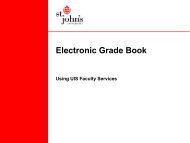Center for Teaching and Learning - St. John's University
Center for Teaching and Learning - St. John's University
Center for Teaching and Learning - St. John's University
Create successful ePaper yourself
Turn your PDF publications into a flip-book with our unique Google optimized e-Paper software.
2<br />
<strong>Center</strong> <strong>for</strong> <strong>Teaching</strong><br />
<strong>and</strong> <strong>Learning</strong><br />
DIRECTOR:<br />
Maura C. Flannery<br />
ASSISTANT DIRECTOR:<br />
Elaine Carey<br />
ASSISTANT TO THE<br />
DIRECTOR:<br />
Lisa Getman<br />
DEPARTMENTAL<br />
ASSISTANT<br />
Judy Lam<br />
2007-2009 FELLOWS:<br />
Florin Catrina<br />
Sue Ford<br />
Marc Gillespie<br />
Marianallet Mendez<br />
Mary Noe<br />
Kristin Prevallet<br />
2006-2008 FELLOWS:<br />
Olga Hilas<br />
<strong>St</strong>even Mentz<br />
<strong>St</strong>ephen P. Miller<br />
Susie Pak<br />
Kathryn Shaughnessy<br />
Victoria Shoaf<br />
Ellen Tufano<br />
SENIOR FELLOWS:<br />
Laura Gianni Augusto<br />
Barrett Brenton<br />
Elaine Carey<br />
Teresa Danile<br />
Hilmi Elifoglu<br />
Carol Fletcher<br />
Lucy Heckman<br />
Aliya Holmes<br />
Nicole Maisch<br />
Joseph Marotta<br />
Mark Meng<br />
Basilio Monteiro<br />
Claire O’Donoghue<br />
Jean-Pierre Ruiz<br />
Sharon See<br />
Jay Zimmerman<br />
This newsletter is<br />
published monthly<br />
during the academic<br />
year by the <strong>Center</strong> <strong>for</strong><br />
<strong>Teaching</strong> <strong>and</strong> <strong>Learning</strong>.<br />
Managing Editor:<br />
Lisa Getman<br />
online, scholars may contact archivists who send the catalogues. In turn, we make<br />
an appointment <strong>and</strong> request what documents we wish to use. I have received<br />
catalogues from the Anslinger Collection at Penn <strong>St</strong>ate <strong>University</strong> <strong>and</strong> DEA-BNDD<br />
Papers at the National Archives. In these archives, when a researcher arrives,<br />
archivists have pulled the documents. Moreover, they offer help with any other<br />
materials. If they invite you to lunch, that is simply an added bonus.<br />
Mexico is completely different. Since 2000, the government has initiated a<br />
freedom of access <strong>and</strong> professional service m<strong>and</strong>ates in part motivated by the<br />
dem<strong>and</strong>s of activists from the 1968 Mexican student movement. The<br />
professionalization has had a dramatic <strong>and</strong> positive effect. For example, previously<br />
published books of photos from the INAH Fototeca, the national photographic<br />
archive, contained many images that authors never cited. In my conversations with<br />
the director, I discovered that the Fototeca now exercises greater control over<br />
images <strong>and</strong> their reproduction. The request process is more rigorous <strong>and</strong> the fees<br />
to publish are much more expensive. Such shifts, however, allow the archive to<br />
maintain control as well as continue its work. Since the archive requests a copy of<br />
all material containing images (this is also the protocol of US archives), its library is<br />
far more extensive than it was ten years ago.<br />
For the AGN, there is a searchable database on the web, but it is clunky <strong>and</strong><br />
difficult to use. Moreover, many of the people at the AGN have yet to be trained<br />
in the new database. Much of the staff is more com<strong>for</strong>table with the printed<br />
catalogues. At times, when I requested materials that I found on the database,<br />
AGN workers told me that those documents did not exist or were not housed in<br />
their areas. This meant going back <strong>and</strong> <strong>for</strong>th between various areas of the archive<br />
to try <strong>and</strong> gain access. Many of the documents in the collections that I wished to<br />
use have never been catalogued whether in print or electronically. In one<br />
collection, there were over 300 boxes with up to 80 files per box. As the archivist<br />
<strong>and</strong> I began to get to know each other, he asked me if I would count the files in<br />
each of the boxes <strong>and</strong> mark the number on each box.<br />
In Mexico, transparency laws led to the release of documents that had been secret,<br />
but systematic problems exist. In areas of more sensitive materials that I have used<br />
since 2000, the scholar is required to obtain a letter of access. I have kept copies of<br />
those letters, but I also keep a record of the names of the archivists who I have<br />
worked with in the past. That way, when I return <strong>and</strong> wish to use the same area, I<br />
mention that I worked there previously <strong>and</strong> with whom I worked.<br />
For continued work, I have a few basic suggestions.<br />
1. Submit all your publications based on the archive or collections that you<br />
accessed <strong>and</strong> used. Many scholars do not do this, <strong>and</strong> it is a huge oversight.<br />
When you return, your work as well as professional recognition of the<br />
archive <strong>and</strong> its staff is on record. This is very important in Mexico.<br />
2. Keep a list of the archivists <strong>and</strong> staff that helped you <strong>and</strong> in what area they<br />
worked—also those that are not too helpful. In the future, you will know<br />
to avoid them. Review that when returning to the archive. Seek out those<br />
people who were helpful. If they don’t remember you, remind them about<br />
when you worked with them.<br />
3. After completing a research trip <strong>and</strong> follow up with the archivists <strong>and</strong> staff.<br />
Send an email thanking them. Send a letter or email to the director of the<br />
archive praising those who helped.<br />
4. Lastly <strong>and</strong> most importantly, be flexible, be patient, <strong>and</strong> maintain a sense<br />
of humor. The work may take more time than in a US archive, but your<br />
experience will add to all aspects of your professional life, whether<br />
measured in publications or in the classroom.
















